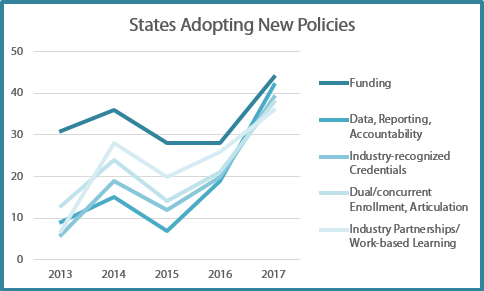Now that the spring 2020 semester has come to a close, schools, colleges and learners across the country are left with the uncomfortable question: what happens next? Amid the COVID-19 (Coronavirus) pandemic, the U.S. has faced widespread school closures and an unprecedented – albeit clunky – transition to remote learning. Even as states begin to lift restrictions, the path ahead is still uncertain.
Last week the National Alliance of Concurrent Enrollment Partnerships (NACEP) and Advance CTE explored some of the ways the Coronavirus has impacted – and will continue to impact – Career Technical Education (CTE) and Early Postsecondary Opportunities (EPSO), which include dual enrollment, dual credit, concurrent enrollment and other related opportunities. There is no silver bullet solution to these challenges, but state leaders and postsecondary institutions are already thinking of ways to minimize the impact on learners and, to the extent possible, to support continuity of learning through the summer and into the fall.
Hold Learners Harmless
One principle states and educational institutions should commit to is to hold learners harmless from the impacts of the Coronavirus, particularly the financial and academic burdens. States like Ohio have already taken steps to protect learners, issuing guidance that prohibits school districts from seeking reimbursement from students who withdraw from a postsecondary course due to Coronavirus-related disruptions.
Further, states are honoring students’ commitment to learning by giving them opportunities to earn credit for the work they have completed. In North Carolina, graduating high school seniors who are enrolled in EPSO courses will be given a passing grade – coded “PC19” to indicate the unusual circumstances of the pandemic – to ensure they can still meet graduation requirements. States like Georgia and Louisiana are giving learners additional time to complete course requirements over the summer.
Commit to Transparency
As states, higher education systems and local institutions adjust grading policies amid Coronavirus-related shutdowns, they must commit to transparency and provide clarity about how credit transfer will be supported. There are questions about binary grades and their impact on the transferability of EPSO courses to two-year and four-year institutions. States with guaranteed transfer acceptance and institutions with transparent policies for addressing binary credit offer students their best option. Some states have begun to release guidance on EPSOs including CTE dual credit opportunities, which NACEP has compiled here.
Don’t be Afraid to Innovate
States and institutions have adapted remarkably well to social distancing on a very short timeframe, but the hands-on, practical learning experiences that make CTE unique and compelling are often not easy to simulate in a remote or online format. That said, necessity is the mother of invention. Instructors and administrators have started finding creative solutions to maintain continuity of learning, from manufacturing products out of household supplies to distributing at-home lab kits. In Illinois, the Community College Board, Board of Higher Education and Illinois Articulation Initiative are allowing the transfer of credits for lab science course offerings that are delivered through nontraditional formats such as simulations, online labs or at-home science kits. In some cases, campuses are exploring ways to safely facilitate hands-on learning over the summer by cutting class sizes or offering intensive summer bootcamps – all while adhering to social distancing guidelines – to help learners make up missed hours.
Keep Equity Front and Center in Funding
As states face declining revenue and anticipate budget cuts in education and elsewhere, they must consider the critical role these programs play in their societal and economic recovery after the pandemic. Funding to decrease the cost of postsecondary education is an important equity lever to help ensure that the talent pipeline into high-skill, high-wage and in-demand occupations includes the entirety of their diverse communities. But a blanket approach to budget reduction, where all learners receive the same benefit, may imperil this approach.
States should analyze their EPSO funding with an equity lens and, when needed, make cuts that don’t disproportionately impact learners traditionally underrepresented in higher education. Increases in cost to the learner, driven by budget cuts, disproportionately impact learners from economically disadvantaged families who cannot absorb a change in cost like an affluent student can. As states assess the impact of this pandemic on education budgets, they should consider strategic changes to help under-resourced school districts, to address affordability for those students that are most price sensitive, and to look thoughtfully about ways to build access to those underrepresented in higher education. Focusing on equity will be critical to ensure budget cuts don’t exacerbate equity gaps in higher education and ultimately the workforce.
Recognize the Role in Recovery
As state and the national economy recovers and reconfigures, states will be looking to ensure they have a strong, robust talent pipeline to address their current, evolving and future workforce needs. There is a lot of uncertainty in forecasting what the labor market and economy will look like in the next three to five years, but it is certain that revitalizing state economies will depend on access to a skilled, educated workforce. States that have invested in career pathways approaches tied to workforce needs, have strong business and industry engagement in CTE, and strong connections between secondary and postsecondary education and industry already understand the value of these programs in driving the state economy. These relationships and a willingness to partner will yield dividends as states emerge from this crisis.
It is too early to measure the true impact of the Coronavirus on postsecondary readiness and credit attainment, but states and institutions can already anticipate some of the barriers that will come and take steps to address them. The time to act is now. States can and should clarify their policies on CTE EPSOs and ensure that the weight of school closures and learning disruption does not unnecessarily harm learners, particularly those who have the most to benefit from these opportunities.
This blog post is the second in a two-part series about the impacts of the Coronavirus on CTE dual enrollment. It was written by Amy Williams, Executive Director of NACEP, and Austin Estes, Manager of Data & Research for Advance CTE.
 Earlier this week a small group of conservative House lawmakers, primarily members of the House Freedom Caucus led by Representative Matt Gaetz (R-FL), introduced a motion to vacate on Monday, October 2 – a formal legislative measure that ejects the sitting Speaker of the House from this position. As a reminder, in order to become Speaker earlier this year, Kevin McCarthy was forced to give a number of concessions related to the House’s rules to this group of conservative lawmakers given the extremely narrow margin of control in the chamber. Among these concessions was a rule change that allows any single Republican member to introduce a motion to vacate. This rule change has given rank-and-file members in the House enormous control over the legislative process this year given they could threaten to oust the Speaker with this procedural measure.
Earlier this week a small group of conservative House lawmakers, primarily members of the House Freedom Caucus led by Representative Matt Gaetz (R-FL), introduced a motion to vacate on Monday, October 2 – a formal legislative measure that ejects the sitting Speaker of the House from this position. As a reminder, in order to become Speaker earlier this year, Kevin McCarthy was forced to give a number of concessions related to the House’s rules to this group of conservative lawmakers given the extremely narrow margin of control in the chamber. Among these concessions was a rule change that allows any single Republican member to introduce a motion to vacate. This rule change has given rank-and-file members in the House enormous control over the legislative process this year given they could threaten to oust the Speaker with this procedural measure. 

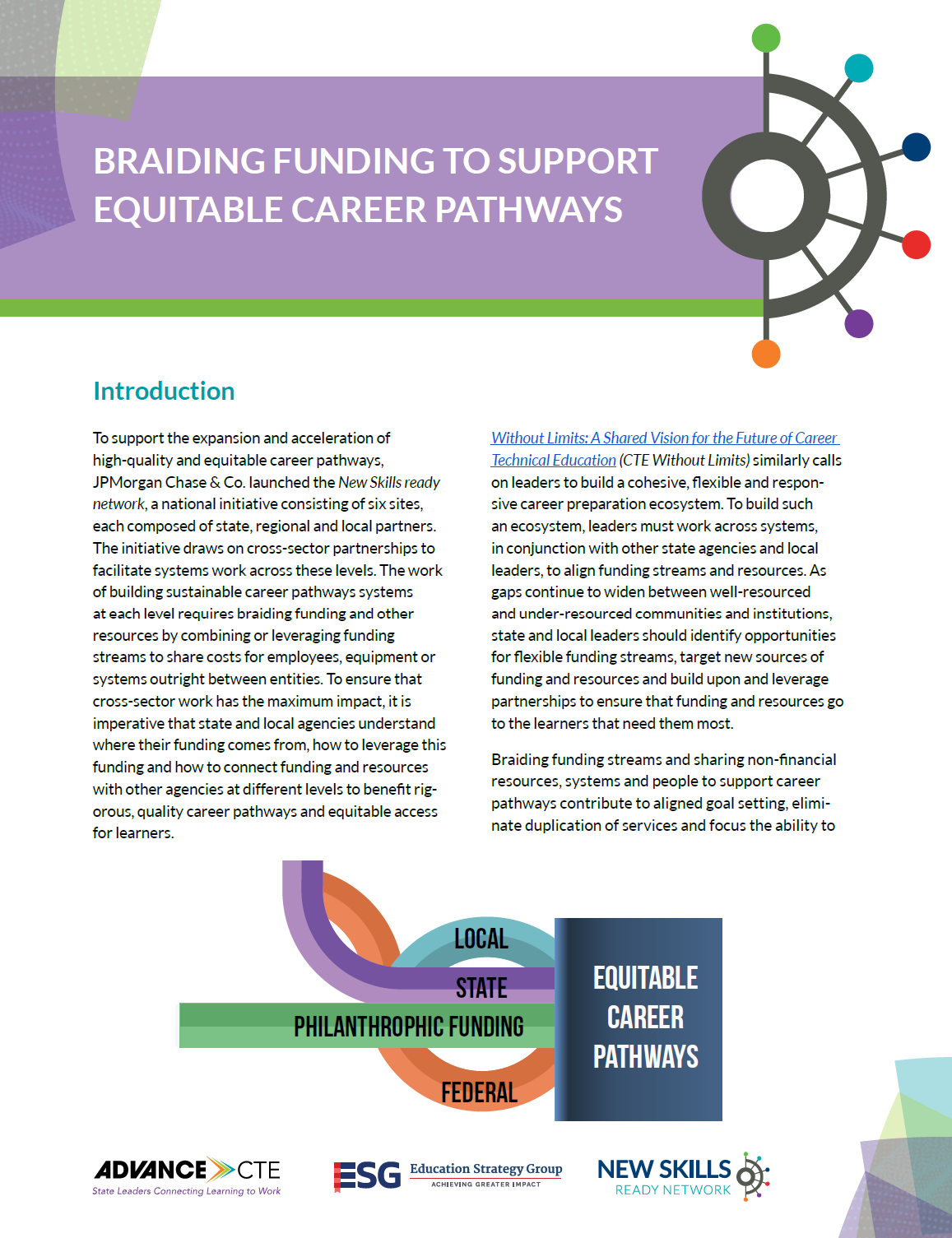 In support of this effort, Advance CTE recently published
In support of this effort, Advance CTE recently published 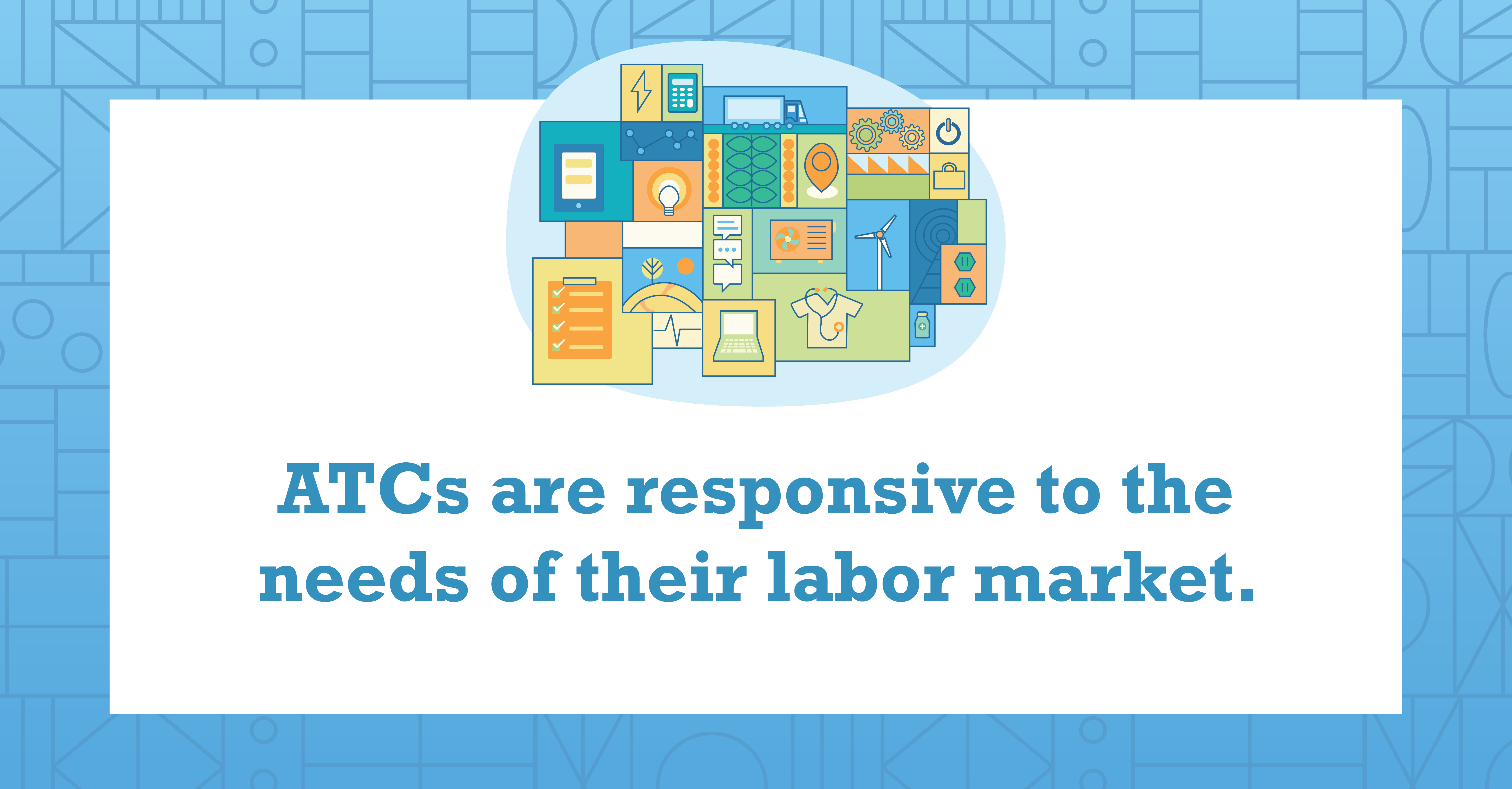 The transformative workforce changes resulting from the COVID-19 (coronavirus) pandemic have made it more urgent than ever for states to have a comprehensive strategy for reskilling and upskilling that unites stakeholders across education, workforce development and economic development. Advance CTE has been
The transformative workforce changes resulting from the COVID-19 (coronavirus) pandemic have made it more urgent than ever for states to have a comprehensive strategy for reskilling and upskilling that unites stakeholders across education, workforce development and economic development. Advance CTE has been  ths, Advance CTE and the Institute of Education Sciences (IES) have worked together to highlight the power of Career Technical Education (CTE) research partnerships in improving quality and equity in CTE. In
ths, Advance CTE and the Institute of Education Sciences (IES) have worked together to highlight the power of Career Technical Education (CTE) research partnerships in improving quality and equity in CTE. In  There is good news for state leaders and researchers interested in initiating CTE research partnerships. NCER has just released its Fiscal Year 2021 Request for Applications (RFA) for its
There is good news for state leaders and researchers interested in initiating CTE research partnerships. NCER has just released its Fiscal Year 2021 Request for Applications (RFA) for its  This blog was
This blog was 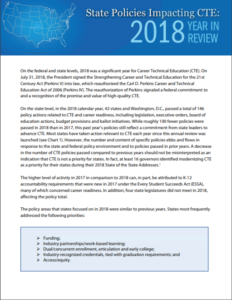 2018 was a significant year for Career Technical Education (CTE) at the federal and state levels. On July 31, 2018, the President signed the Strengthening Career and Technical Education for the 21st Century Act (Perkins V) into law, which reauthorized the Carl D. Perkins Career and Technical Education Act of 2006 (Perkins IV). The reauthorization of Perkins signaled a federal commitment to and a recognition of the promise and value of high-quality CTE. Additionally, at the state level 42 states and Washington, D.C., passed a total of 146 policy actions related to CTE and career readiness, reflecting a commitment from state leaders to advance CTE.
2018 was a significant year for Career Technical Education (CTE) at the federal and state levels. On July 31, 2018, the President signed the Strengthening Career and Technical Education for the 21st Century Act (Perkins V) into law, which reauthorized the Carl D. Perkins Career and Technical Education Act of 2006 (Perkins IV). The reauthorization of Perkins signaled a federal commitment to and a recognition of the promise and value of high-quality CTE. Additionally, at the state level 42 states and Washington, D.C., passed a total of 146 policy actions related to CTE and career readiness, reflecting a commitment from state leaders to advance CTE.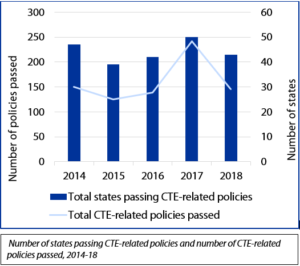 While roughly one hundred fewer policies were passed in 2018 than in 2017, this past year’s policies still reflect a commitment from state leaders to advance CTE. A decrease in the number of CTE policies passed compared to previous years should not be misinterpreted as an indication that CTE is not a priority for states. In fact,
While roughly one hundred fewer policies were passed in 2018 than in 2017, this past year’s policies still reflect a commitment from state leaders to advance CTE. A decrease in the number of CTE policies passed compared to previous years should not be misinterpreted as an indication that CTE is not a priority for states. In fact,  census. The census is pivotal to understanding the composition of the country, but it also plays a large role in federal funding levels of major programs. In fact, the U.S. Census Bureau reported that education programs are some of the biggest to use census data to determine funding. For example, the Pell Grant program utilizes census data and was allotted $29.8 billion dollars in 2015.
census. The census is pivotal to understanding the composition of the country, but it also plays a large role in federal funding levels of major programs. In fact, the U.S. Census Bureau reported that education programs are some of the biggest to use census data to determine funding. For example, the Pell Grant program utilizes census data and was allotted $29.8 billion dollars in 2015. The points an institution receives in the formula for credential attainment are multiplied if the credentials are in Science, Technology, Engineering and Mathematics (STEM) or state-defined “high-demand” fields. Qualifying fields are designated by the the Arkansas Department of Higher Education and the Department of Workforce Services. The multiplier for STEM degrees is 3 points; the multiplier for degrees in high-demand fields is 1.5 points.
The points an institution receives in the formula for credential attainment are multiplied if the credentials are in Science, Technology, Engineering and Mathematics (STEM) or state-defined “high-demand” fields. Qualifying fields are designated by the the Arkansas Department of Higher Education and the Department of Workforce Services. The multiplier for STEM degrees is 3 points; the multiplier for degrees in high-demand fields is 1.5 points. 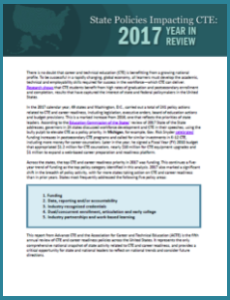 2017 was a banner year for Career Technical Education (CTE). Overall, 49 states and the District of Columbia passed a total of 241 policies related to CTE and career readiness, a marked increase from 2016. But while it is encouraging to see a groundswell of enthusiasm for CTE at the local, state and national levels, how will states leverage CTE’s momentum and ensure that state action translates to better outcomes for students?
2017 was a banner year for Career Technical Education (CTE). Overall, 49 states and the District of Columbia passed a total of 241 policies related to CTE and career readiness, a marked increase from 2016. But while it is encouraging to see a groundswell of enthusiasm for CTE at the local, state and national levels, how will states leverage CTE’s momentum and ensure that state action translates to better outcomes for students? 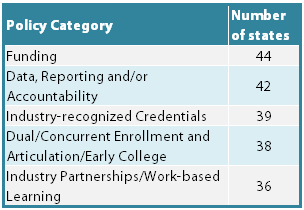 There was also a lot of activity related to data, reporting and accountability, largely due to state work around the Every Student Succeeds Act (ESSA). In 2017, 35 states identified measures of career readiness in their federal accountability systems, and many of these measures included industry-recognized credential attainment, dual-credit completion and work-based learning participation.
There was also a lot of activity related to data, reporting and accountability, largely due to state work around the Every Student Succeeds Act (ESSA). In 2017, 35 states identified measures of career readiness in their federal accountability systems, and many of these measures included industry-recognized credential attainment, dual-credit completion and work-based learning participation.